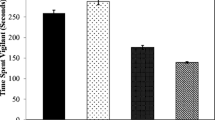Abstract
The effects of woodlot size and isolation, in relation to habitat fragmentation, on the distribution of the red squirrel were studied. In The Netherlands, 50 woodlots (0.55–13.78 ha) were surveyed in an agricultural landscape for the presence of red squirrel. In 26 woodlots squirrel dreys (nests) were found. Logit regression analysis showed that woodlot size and the area per woodlot covered with coniferous trees were the best predictors of squirrel presence. Addition of isolation variables by means of a stepwise forward regression method showed significant effects of the distance to a large, permanently inhabited wood and the amount of surrounding wood. No effect was found for the distance to the nearest woodlot (>0.5 ha). The model could be further improved by adding a measure of the amount of hedgerows surrounding a woodlot.
Similar content being viewed by others
References
Brönmark, C. 1985. Freshwater snail diversity: effects of pond area, habitat heterogeneity and isolation. Oecologia 67: 127–131.
Corbel, G.B. and Southern, H.N. (eds.) 1977. The handbook of British mammals. Blackwell Scientific Publications, London.
Don, B.A. 1985. The use of drey counts to estimate Grey squirrel populations. J. Zool., Lond. 206: 282–286.
Genstat 5 committee 1987. Genstat 5 Reference Manual. Oxford University Press, Oxford.
Getz, L.L., Cole, F.R. and Gates, D.L. 1978. Interstate roadsides as dispersal routes for Microtus pennsylvanicus. J. Mammal. 59: 208–212.
Geuse, P., Bauchau, V. and Le Boulengé, E. 1985. Distribution and population dynamics of bank voles and wood mice in a patchy woodland habitat in central Belgium. Acta Zool. Fennica 173: 65–68.
Gottfried, B.M. 1979. Small mammal populations in woodland islands. Am. Midl. Nat. 102: 105–112.
Henderson, M.T., Merriam, G. and Wegner, J. 1985. Patchy environments and species survival: chipmunks in an agricultural mosaic. Biol. Conserv. 31: 95–105.
Jongman, R.H.G., Ter Braak, C.J.F. and Van Tongeren, O.F.R. 1987. Data analysis in community and landscape ecology. Centre for Agricultural Publishing and Documentation (Pudoc), Wageningen.
Levins, R. 1970. Extinction. In: Some mathematical questions in biology. Lectures on Mathematics in the Life Sciences Vol. 2: 75–101. Am. Math.-Soc., Rhode Island.
Opdam, P. 1988. Populations in fragmented landscape. In: Schreiber, K.-F. (ed.). Connectivity in Landscape Ecology. Proceedings of the 2nd International Seminar of the “International Association for Landscape Ecology”, Münstersche Geografische Arbeiten 29, Münster.
Pokki, J. 1981. Distribution, demography and dispersal of the field vole, Microtus agrestis (L.), in the Tvärminne archipelago, Finland. Acta Zool. Fennica 164: 1–48.
Smith, G.T. 1974. The distribution and dispersal of Pikas: consequences of insular population structure. Ecology 55:1112–1119.
Soesbergen, M. and Mabelis, A. 1989. Evertebraten in een versnipperd landschap. In: Insektenfauna en Natuurbeheer. Wetenschappelijke Mededeling 192, K.N.N.V., Utrecht.
Tonkin, J.M. 1983. Red squirrel ecology. PhD thesis, University of Bradford, Bradford.
Van Dorp, D. and Opdam, P.F.M. 1987. Effects of patch size, isolation and regional abundance on forest bird communities. Landsc. Ecol. 1: 59–73.
Wauters, L.A. and Dhondt, A.A. 1986. Dichtheid en home ranges van een populatie eekhoorns Sciurus vulgaris L., 1758 in België. Lutra 29: 243–260 (with English summary).
Wauters, L.A. and Dhondt, A.A. 1987. Activity budget and foraging behaviour of the red squirrel (Sciurus vulgaris Linnaeus, 1758) in a coniferous habitat. Z. Säugetierk. 52: 341–353.
Wauters, L.A. and Dhondt, A.A. 1988. The use of red squirrel (Sciurus vulgaris) dreys to estimate population density. J. Zool. 214: 179–187.
Wauters, L.A. and Dhondt, A.A. Nest-use by red squirrels (Sciurus vulgaris Linnaeus, 1758). Mammalia: in press.
Author information
Authors and Affiliations
Rights and permissions
About this article
Cite this article
Verboom, B., van Apeldoorn, R. Effects of habitat fragmentation on the red squirrel, Sciurus vulgaris L.. Landscape Ecol 4, 171–176 (1990). https://doi.org/10.1007/BF00132859
Issue Date:
DOI: https://doi.org/10.1007/BF00132859




